Home Exercises Part 1: Cobra
This blog post is the first in a series featuring some common home exercises. Over the coming year we will put several popular exercises under scrutiny to examine how they stack up—or not—against the principles of healthy posture.
The 1960s to now
Some exercises remain very persistent in fitness folklore, handed down through the decades in fitness regimens and by personal trainers and gym instructors. However, just because an exercise attains iconic status does not guarantee it is a healthy exercise.

The content of many popular home exercise programs can be traced back to the 1960s. Wikipedia
Many of today’s exercise “favorites” were popularized by the Royal Canadian Air Force Exercise Plans, first published in 1961. Its 5BX (Five Basic Exercises) for men and XBX (Ten Basic Exercises) for women became highly influential in many countries around the world. Both were subsequently combined into one book, which was republished as recently as 2016.
There have been numerous fads, fashions, discoveries, and innovations in exercise since the 1960s, including many recent Internet influencers. What our students told us they wanted was motivational and safe exercise with a Gokhale (Go-Clay) filter. A long time ambition to offer a truly healthy posture-based exercise program, open to all, finally came to fruition as Gokhale Exercise in April 2020.
“First, do no harm”
People usually take up exercise to become fitter, stronger, and more resilient. They may have experienced an episode of back pain and been advised to strengthen their back and core muscles. Unfortunately, many of the exercises offered as remedies are taught in a way that can do further damage to the discs, nerves, bones, and tissues already compromised by the poor posture at the root of the problem.
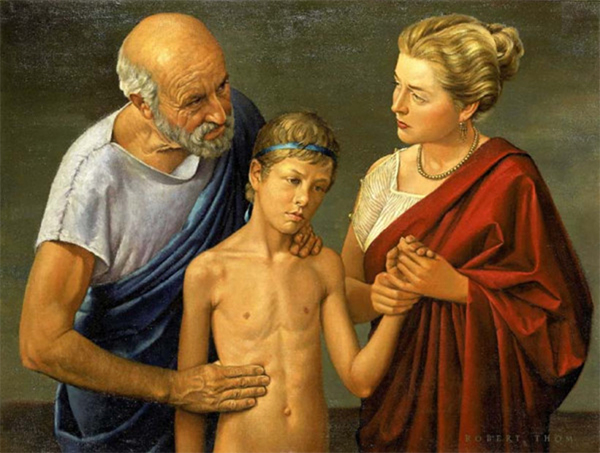
Hippocrates examining a child, a painting by Robert Thom, 1950s. Researchgate
You want a starting point which, at the very least, honors the instruction attributed to the ancient Greek physician Hippocrates: “First, do no harm.”
Make healthy progress
But beyond avoiding damage, it would also be nice to have exercises that will reeducate the mind and body in healthy everyday movement patterns and posture. This enables you to not only heal and become pain-free, but also to become stronger, resilient to injury, and to progress over the long term.
Let’s look at Cobra

BKS Iyengar, widely regarded in the West as the father of modern yoga, in Cobra Pose. He keeps his back straight, with the exception of deep articulation at the lumbosacral junction. The significance of this L5-S1 angle has been largely overlooked by his students. Yogavanpoll
Cobra is regarded as a go-to exercise for strengthening the lower back. It features in the Canadian Air Force exercises and is also a mainstay in various traditions of yoga, where it is known by its Sanskrit name, Bhujangasana (Snake Pose). With the upper body supported away from the ground by the arms and an expanded chest, it resembles a rearing cobra, a common Indian snake.

This practitioner has excessive angles of bend in his upper lumbar spine and neck.
Any bend in the upper lumbar spine should be minimal and evenly distributed; the angle at L5-S1 can be pronounced. Pixahive
The majority of people are already prone to sway and compress their upper lumbar spine. For these people, Cobra carries a risk of exacerbating the compression they already have too much of. It also reinforces their baseline habit of swaying, which includes flaring the front of the rib cage.
You may be wondering if Cobra is an exercise that you should never do. Cobra pose can be done in a healthy way, but it requires attention to detail and training.
A healthy Cobra Pose

Length is the healthy priority in Cobra, not lift or bend.
To be healthy, Cobra should focus not on bending at or lifting up from the lumbar area but on reeducating the lumbar spine to be lengthened and straighter, and bending back mainly from L5-S1. This requires a strong muscular action in the front of the torso, which we call the rib anchor. The muscles of the rib anchor will oppose excessive contraction of the erector spinae, the long back muscles on either side of the spine.
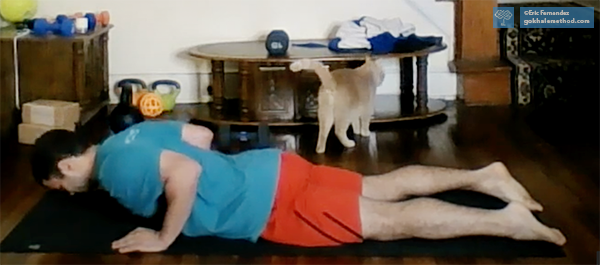
Gokhale Exercise teacher Eric Fernandez demonstrates a modified Cobra Pose.
In the Baby Cobra that we teach, your aim is to lift just a few inches away from the floor whilst maintaining good postural form. A strong rib anchor will prevent the low back from swaying and as a result encourages articulation in the spine to occur at the lumbosacral junction. Any curve in the spine will be extremely mild, including at the neck, so the back of the neck should remain lengthened with your face downward. Your shoulders will remain back. Your long back muscles will work evenly and in sync with your rib anchor to lift you safely. You can watch our free rib anchor and shoulder roll videos to prepare for Baby Cobra.
CAUTION: If you have had a surgical fusion at L5-S1, pain, or any suspicion of herniation in your lower discs, you should not attempt Cobra.
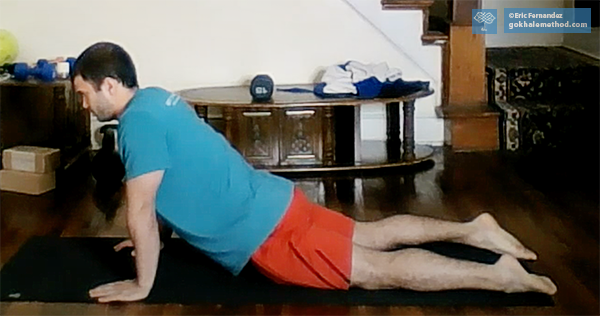
If you have the strength to come up higher it is fine to do so, maintaining your rib anchor.
The less mobility you have at L5-S1, the further your pelvis will be from the floor.
Does Cobra “fix” back pain?
One of the more well-known schools of physical therapy, the McKenzie Method, uses a Cobra-like position to address back pain. In this case it is done not by lifting from horizontal up into extension but by resting in extension propped up on the elbows. Students are not instructed about where any back curve should happen.
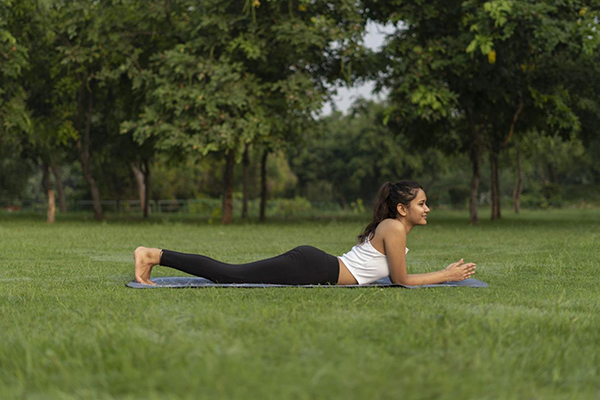
Resting on the elbows usually encourages a compressive sway in the mid-back
rather than articulation at the lumbosacral junction. Pixahive
The Gokhale Method view is that for a few people who are stiff in their lumbar area, the stiffness may play a protective role in this prone, extended position, and can enable them to gain some healthy mobility at the lumbosacral junction while avoiding sway. For most people, given their tendency to sway, a backbend is not a good measure (and is usually a bad measure) for a back problem.
In fact, it's rare that any single exercise, or exercises alone, provide a fix for a back problem. In our experience, relearning healthy posture as taught in the Gokhale Method Foundations Course and online Elements course gives a robust, effective, and ultimately efficient way of addressing all sorts of back (and other musculoskeletal) problems. For independent data on this, click here.
Modified Cobra, done well, strengthens your torso and is a good way to consolidate and vary your practice of healthy posture. If you would like to learn how to do Cobra the Gokhale Method way, plus two additional exercises, join our Free Online Workshop, Which Three Common Exercises Get the Worst Gokhale Rating, on June 5th. You can sign up here.
If you are looking for a way to exercise regularly that is healthy for your back and improves your posture, sign up for our Gokhale Exercise Free Trial:
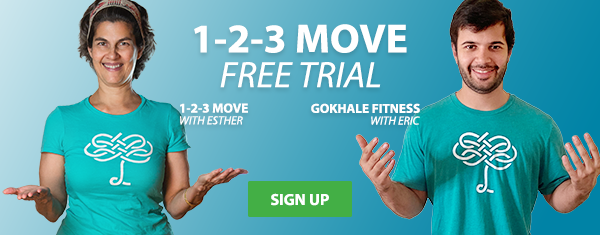
1-2-3 Move happens daily with Esther at 9:45 a.m. (Pacific Time)
Gokhale Fitness with Eric runs Mondays, Wednesdays, Fridays from 7–7:25 a.m.
(Pacific Time), and Tuesdays, Thursdays, Saturdays from 3–3:25 p.m. (Pacific Time)

Comments
Add New Comment
Login to add commment
Login